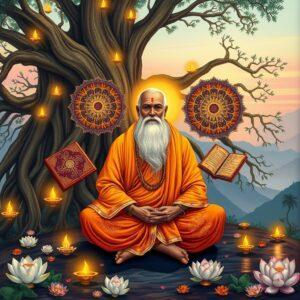
Delve into the fascinating world of Prakrit, a group of vernacular classical Middle Indo-Aryan languages used across the Indian subcontinent from approximately the 5th century BCE to the 12th century CE. This exploration unveils Prakrit’s origins, meanings, and enduring impact on Indian culture, particularly within Jainism and Buddhism.
Historical Context and Evolution
Emerging from Sanskrit, Prakrit languages evolved into diverse regional dialects, playing a vital role in ancient Indian literature, especially Jain and Buddhist scriptures. Distinct Prakrit variations arose across different regions, each with unique characteristics:
- Maharashtri: Frequently employed in poetry and drama, Maharashtri Prakrit contributed significantly to the development of the Marathi language.
- Sauraseni: Prevalent in northern India, Sauraseni Prakrit is found in numerous Jain texts and served as a foundation for modern Hindi.
- Magadhi: Spoken in the eastern regions, Magadhi Prakrit is closely associated with Buddhist teachings and scriptures.
Over centuries, Prakrit’s influence permeated numerous modern Indian languages, shaping their structure and vocabulary.
Prakrit Word for Dharma
The Prakrit term for Dharma, “Dhamma,” carries its own unique etymology, varying in meaning based on context. In Jainism and Buddhism, Dhamma holds profound significance, representing moral law, truth, and the path to enlightenment. Subtle differences exist between the Prakrit Dhamma and its Sanskrit counterpart in interpretation and nuance.
Prakrit literature and inscriptions often depict Dhamma as the guiding moral principle. Key texts like the Jain “Acaranga Sutra,” written in Prakrit, elucidate the core principles of Dhamma.
Prakrit Ka Arth (The Meaning of Prakrit)
Understanding the meanings of Prakrit words (“Prakrit ka arth”) is crucial for preserving cultural heritage. Common Prakrit words and their meanings reveal their historical and religious significance:
- Ahimsa: Non-violence, a central tenet in Jainism and Buddhism, emphasizing the importance of respecting all living beings.
- Samsara: The cycle of birth, death, and rebirth, a core concept in Hindu, Buddhist, and Jain philosophies, explaining the continuous process of existence.
Etymological research helps uncover the rich meanings embedded within Prakrit words. However, accurate translation can be challenging due to regional variations and historical shifts.
Prakrit Meaning and Etymology
Prakrit words encapsulate cultural, religious, and philosophical concepts. Deciphering their meanings involves linguistic analysis and historical context. Significant Prakrit words have left a lasting impact on Indian culture and traditions. Modern linguistic studies continue to explore the relevance of Prakrit today.
Prakrit Etymology Dictionary
A Prakrit etymology dictionary is an invaluable tool for researchers and enthusiasts. Compiling such a dictionary requires meticulous sourcing from ancient texts, inscriptions, and manuscripts. Key dictionaries and resources aid in the study of Prakrit etymology.
An example entry might include:
- Gaha: Meaning ‘song’ or ‘verse’, often used in poetic compositions, highlighting Prakrit’s role in literary expression.
Significance for Culturally Rooted Indians
Understanding Prakrit word origins and meanings deepens the connection to Indian history, culture, and traditions. This knowledge enriches religious rituals and helps preserve authentic practices. Explore our collection of Rudraksha malas and incense sticks at poojn.in to enhance your spiritual practices.
Connecting with Shiva’s Sacred Names through poojn.in
Poojn.in offers authentic puja items that connect you with Lord Shiva’s sacred names, many of which have deep Prakrit origins:
- Mahadeva (The Great God): Find pure copper and brass items for abhishekam, honoring this powerful deity.
- Nataraja (Lord of the Dance): Honor Nataraja with traditional dance bells and anklets used in sacred dance rituals, celebrating Shiva’s cosmic dance.
- Rudra (The Fierce One): Connect with Rudra through genuine rudraksha malas and rudraksha-based items, embracing his transformative energy.
- Neelkantha (The Blue-Throated One): Worship Neelkantha using our selection of pure silver items and abhishekam materials, commemorating his sacrifice for the world.
- Bholenath (The Innocent Lord): Offer prayers to Bholenath with our authentic bilva leaves and dhoop items, expressing devotion to his compassionate nature.
Visit poojn.in to explore our complete collection of Shiva puja items, including traditional sindoor containers.
Conclusion
Exploring Prakrit provides a unique window into India’s cultural heritage. Whether for religious rituals or academic interest, understanding Prakrit connects us to ancient traditions and wisdom. Let us continue to appreciate and preserve this beautiful language.
FAQs
What is the Prakrit word for Dharma? The Prakrit word for Dharma is “Dhamma.”
What does “Prakrit ka arth” mean? “Prakrit ka arth” translates to “the meaning of Prakrit.”
What is the meaning of the word Prakrit? Prakrit means “natural” or “original,” referring to languages derived from Sanskrit.


